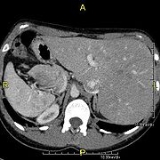
Primary ciliary dyskinesia
Encyclopedia
Primary ciliary dyskinesia (PCD), also known as immotile ciliary syndrome or Kartagener Syndrome (KS), is a rare, ciliopathic
, autosomal
recessive genetic disorder
that causes a defect in the action of the cilia lining the respiratory tract
(lower and upper, sinuses, Eustachian tube
, middle ear
) and fallopian tube
, and also of the flagella of sperm
in males.
Respiratory epithelial
motile cilia, which resemble microscopic "hairs" (although structurally and biologically unrelated to hair
), are complex organelle
s that beat synchronously in the respiratory tract, moving mucus toward the throat. Normally, cilia beat 7 to 22 times per second, and any impairment can result in poor mucociliary clearance
, with subsequent upper and lower respiratory infection. Cilia also are involved in other biological processes (such as nitric oxide
production), which are currently the subject of dozens of research efforts. As the functions of cilia become better understood, the understanding of PCD should be expected to advance.
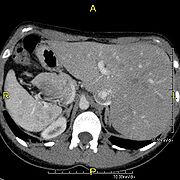
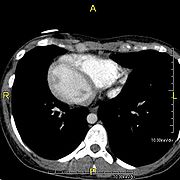
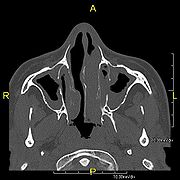 When accompanied by the combination of situs inversus
When accompanied by the combination of situs inversus
(reversal of the internal organs), chronic sinusitis, and bronchiectasis
, it is known as Kartagener syndrome. The phrase "immotile ciliary syndrome" is no longer favored as the cilia do have movement, but may be inefficient or unsychronized.
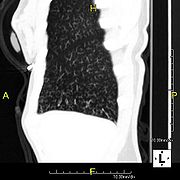
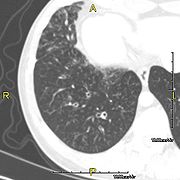
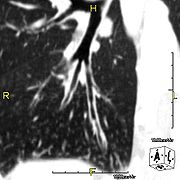 The main consequence of impaired ciliary function is reduced or absent mucus
The main consequence of impaired ciliary function is reduced or absent mucus
clearance from the lung
s, and susceptibility to chronic recurrent respiratory infections, including sinusitis
, bronchitis
, pneumonia
, and otitis media
. Progressive damage to the respiratory system is common, including progressive bronchiectasis beginning in early childhood, and sinus disease (sometimes becoming severe in adults). However, diagnosis is often missed early in life despite the characteristic signs and symptoms. In males, immotility of sperm leads to infertility
, although conception remains possible through the use of in vitro fertilization.
Many affected individuals experience hearing loss and show symptoms of glue ear
which demonstrate variable responsiveness to the insertion of myringotomy
tubes or grommet
s. Some patients have been having a poor sense of smell, which is believed to accompany high mucus
production in the sinuses (although others report normal - or even acute - sensitivity to smell and taste). Clinical progression of the disease is variable with lung transplantation
required in severe cases. Susceptibility to infections can be drastically reduced by an early diagnosis. Treatment with various chest physiotherapy techniques has been observed to reduce the incidence of lung infection and to slow the progression of bronchiectasis dramatically. Aggressive treatment of sinus disease beginning at an early age is believed to slow long-term sinus damage (although this has not yet been adequately documented). Aggressive measures to enhance clearance of mucus, prevent respiratory infections, and treat bacterial superinfections have been observed to slow lung-disease progression. Although the true incidence of the disease is unknown, it is estimated to be 1 in 32,000,
although the actual incidence may be as high as 1 in 15,000.
disorder affecting motile cilia
which are made up of approximately 250 proteins. Around 90% of individuals with PCD have ultrastructural defects affecting protein(s) in the outer and/or inner dynein
arms which give cilia their motility, with roughly 38% of these defects caused by mutations on two genes, DNAI1
and DNAH5
, both of which code for proteins found in the ciliary outer dynein arm.
There is an international effort to identify genes that code for inner dynein arm proteins or proteins from other ciliary structures (radial spokes, central apparatus, etc.) associated with PCD. The role of DNAH5 in heterotaxy syndromes and left-right asymmetry is also under investigation.
arms, central apparatus, radial spokes, etc. are missing or dysfunctional and thus the axoneme
structure lacks the ability to move. Axoneme
s are the elongated structures that make up cilia and flagella. Additionally, there may be chemical defects that interfere with ciliary function in the presence of adequate structure. Whatever the underlying cause, dysfunction of the cilia begins during and impacts the embryo
logic phase of development.
Specialised monocilia are at the heart of this problem. They lack the central-pair microtubules of ordinary motile cilia and so rotate clockwise rather than beat; in Hensen's node
at the anterior end of the primitive streak
in the embryo, these are angled posteriorly such that they prescribe a D-shape rather than a circle. This has been shown to generate a net leftward flow in mouse and chick embryos, and sweeps the Sonic Hedgehog
(Shh) protein
to the left, triggering normal asymmetrical development.
However, in some individuals with PCD, mutations thought to be in the gene coding for the key structural protein left-right dynein
(lrd) result in monocilia which do not rotate. There is therefore no flow generated in the node, Shh moves at random within it, and 50% of those affected develop situs inversus
which can occur with or without dextrocardia
, where the laterality of the internal organs is the mirror-image of normal. Affected individuals therefore have Kartagener syndrome. This is not the case with some PCD-related genetic mutations: at least 6% of the PCD population have a condition called situs ambiguus
or heterotaxy where organ placement or development is neither typical (situs solitus
) nor totally reversed (situs inversus totalis) but is a hybrid of the two. Splenic abnormalities such as polysplenia
, asplenia
and complex congenital heart defects are more common in individuals with situs ambiguus and PCD, as they are in all individuals with situs ambiguus.
The genetic forces linking failure of nodal monocilia and situs issues and the relationship of those forces to PCD are the subject of intense research interest. For now hypotheses abound—some, like the one above, are generally accepted. However, knowledge in this area is constantly advancing.
s, both genetic syndromes
and genetic diseases
, that were not previously identified in the medical literature as related, may be, in fact, highly related in the genetypical
root cause of the widely-varying, phenotypically
-observed disorders. Thus, PCD is a ciliopathy
. Other known ciliopathies include Bardet-Biedl syndrome
, polycystic kidney
and liver disease
, nephronophthisis
, Alstrom syndrome
, Meckel-Gruber syndrome and some forms of retinal degeneration
.
This article may contain some text from the public domain source "National Heart, Lung, and Blood Institute Rare Diseases Report FY 2001" available at http://www.nhlbi.nih.gov/resources/docs/raredisrpt01.htm
Ciliopathy
A ciliopathy is a genetic disorder of the cellular cilia or the cilia anchoring structures, the basal bodies, or of ciliary function.Although ciliopathies are usually considered to involve proteins that localize to the primary cilia or centrosomes, it is possible for ciliopathies to be associated...
, autosomal
Autosome
An autosome is a chromosome that is not a sex chromosome, or allosome; that is to say, there is an equal number of copies of the chromosome in males and females. For example, in humans, there are 22 pairs of autosomes. In addition to autosomes, there are sex chromosomes, to be specific: X and Y...
recessive genetic disorder
Genetic disorder
A genetic disorder is an illness caused by abnormalities in genes or chromosomes, especially a condition that is present from before birth. Most genetic disorders are quite rare and affect one person in every several thousands or millions....
that causes a defect in the action of the cilia lining the respiratory tract
Respiratory tract
In humans the respiratory tract is the part of the anatomy involved with the process of respiration.The respiratory tract is divided into 3 segments:*Upper respiratory tract: nose and nasal passages, paranasal sinuses, and throat or pharynx...
(lower and upper, sinuses, Eustachian tube
Eustachian tube
The Eustachian tube is a tube that links the nasopharynx to the middle ear. It is a part of the middle ear. In adult humans the Eustachian tube is approximately 35 mm long. It is named after the sixteenth-century anatomist Bartolomeo Eustachi...
, middle ear
Middle ear
The middle ear is the portion of the ear internal to the eardrum, and external to the oval window of the cochlea. The mammalian middle ear contains three ossicles, which couple vibration of the eardrum into waves in the fluid and membranes of the inner ear. The hollow space of the middle ear has...
) and fallopian tube
Fallopian tube
The Fallopian tubes, also known as oviducts, uterine tubes, and salpinges are two very fine tubes lined with ciliated epithelia, leading from the ovaries of female mammals into the uterus, via the utero-tubal junction...
, and also of the flagella of sperm
Sperm
The term sperm is derived from the Greek word sperma and refers to the male reproductive cells. In the types of sexual reproduction known as anisogamy and oogamy, there is a marked difference in the size of the gametes with the smaller one being termed the "male" or sperm cell...
in males.
Respiratory epithelial
Epithelium
Epithelium is one of the four basic types of animal tissue, along with connective tissue, muscle tissue and nervous tissue. Epithelial tissues line the cavities and surfaces of structures throughout the body, and also form many glands. Functions of epithelial cells include secretion, selective...
motile cilia, which resemble microscopic "hairs" (although structurally and biologically unrelated to hair
Hair
Hair is a filamentous biomaterial, that grows from follicles found in the dermis. Found exclusively in mammals, hair is one of the defining characteristics of the mammalian class....
), are complex organelle
Organelle
In cell biology, an organelle is a specialized subunit within a cell that has a specific function, and is usually separately enclosed within its own lipid bilayer....
s that beat synchronously in the respiratory tract, moving mucus toward the throat. Normally, cilia beat 7 to 22 times per second, and any impairment can result in poor mucociliary clearance
Mucociliary Clearance
Mucociliary clearance, also referred to as mucociliary apparatus or mucociliar clearance , derived from mucus , cilia and clearance describes the self-clearing mechanism of the bronchi.The main bronchi down to the alveoli are lined with a respiratory epithelium...
, with subsequent upper and lower respiratory infection. Cilia also are involved in other biological processes (such as nitric oxide
Nitric oxide
Nitric oxide, also known as nitrogen monoxide, is a diatomic molecule with chemical formula NO. It is a free radical and is an important intermediate in the chemical industry...
production), which are currently the subject of dozens of research efforts. As the functions of cilia become better understood, the understanding of PCD should be expected to advance.
Classification



Situs inversus
Situs inversus is a congenital condition in which the major visceral organs are reversed or mirrored from their normal positions. The normal arrangement is known as situs solitus...
(reversal of the internal organs), chronic sinusitis, and bronchiectasis
Bronchiectasis
Bronchiectasis is a disease state defined by localized, irreversible dilation of part of the bronchial tree caused by destruction of the muscle and elastic tissue. It is classified as an obstructive lung disease, along with emphysema, bronchitis, asthma, and cystic fibrosis...
, it is known as Kartagener syndrome. The phrase "immotile ciliary syndrome" is no longer favored as the cilia do have movement, but may be inefficient or unsychronized.
Signs and symptoms



Mucus
In vertebrates, mucus is a slippery secretion produced by, and covering, mucous membranes. Mucous fluid is typically produced from mucous cells found in mucous glands. Mucous cells secrete products that are rich in glycoproteins and water. Mucous fluid may also originate from mixed glands, which...
clearance from the lung
Lung
The lung is the essential respiration organ in many air-breathing animals, including most tetrapods, a few fish and a few snails. In mammals and the more complex life forms, the two lungs are located near the backbone on either side of the heart...
s, and susceptibility to chronic recurrent respiratory infections, including sinusitis
Sinusitis
Sinusitis is inflammation of the paranasal sinuses, which may be due to infection, allergy, or autoimmune issues. Most cases are due to a viral infection and resolve over the course of 10 days...
, bronchitis
Bronchitis
Acute bronchitis is an inflammation of the large bronchi in the lungs that is usually caused by viruses or bacteria and may last several days or weeks. Characteristic symptoms include cough, sputum production, and shortness of breath and wheezing related to the obstruction of the inflamed airways...
, pneumonia
Pneumonia
Pneumonia is an inflammatory condition of the lung—especially affecting the microscopic air sacs —associated with fever, chest symptoms, and a lack of air space on a chest X-ray. Pneumonia is typically caused by an infection but there are a number of other causes...
, and otitis media
Otitis media
Otitis media is inflammation of the middle ear, or a middle ear infection.It occurs in the area between the tympanic membrane and the inner ear, including a duct known as the eustachian tube. It is one of the two categories of ear inflammation that can underlie what is commonly called an earache,...
. Progressive damage to the respiratory system is common, including progressive bronchiectasis beginning in early childhood, and sinus disease (sometimes becoming severe in adults). However, diagnosis is often missed early in life despite the characteristic signs and symptoms. In males, immotility of sperm leads to infertility
Infertility
Infertility primarily refers to the biological inability of a person to contribute to conception. Infertility may also refer to the state of a woman who is unable to carry a pregnancy to full term...
, although conception remains possible through the use of in vitro fertilization.
Many affected individuals experience hearing loss and show symptoms of glue ear
Otitis media
Otitis media is inflammation of the middle ear, or a middle ear infection.It occurs in the area between the tympanic membrane and the inner ear, including a duct known as the eustachian tube. It is one of the two categories of ear inflammation that can underlie what is commonly called an earache,...
which demonstrate variable responsiveness to the insertion of myringotomy
Myringotomy
Myringotomy is a surgical procedure in which a tiny incision is created in the eardrum, so as to relieve pressure caused by the excessive build-up of fluid, or to drain pus. Myringotomy is often performed as a treatment for acute suppurative otitis media...
tubes or grommet
Grommet
thumb|right|250px|Some rubber grommets.A grommet is a ring inserted into a hole through thin material, such as fabric. Grommets are generally flared or collared on each side to keep them in place, and are often made of metal, plastic, or rubber. They may be used to prevent tearing or abrasion of...
s. Some patients have been having a poor sense of smell, which is believed to accompany high mucus
Mucus
In vertebrates, mucus is a slippery secretion produced by, and covering, mucous membranes. Mucous fluid is typically produced from mucous cells found in mucous glands. Mucous cells secrete products that are rich in glycoproteins and water. Mucous fluid may also originate from mixed glands, which...
production in the sinuses (although others report normal - or even acute - sensitivity to smell and taste). Clinical progression of the disease is variable with lung transplantation
Organ transplant
Organ transplantation is the moving of an organ from one body to another or from a donor site on the patient's own body, for the purpose of replacing the recipient's damaged or absent organ. The emerging field of regenerative medicine is allowing scientists and engineers to create organs to be...
required in severe cases. Susceptibility to infections can be drastically reduced by an early diagnosis. Treatment with various chest physiotherapy techniques has been observed to reduce the incidence of lung infection and to slow the progression of bronchiectasis dramatically. Aggressive treatment of sinus disease beginning at an early age is believed to slow long-term sinus damage (although this has not yet been adequately documented). Aggressive measures to enhance clearance of mucus, prevent respiratory infections, and treat bacterial superinfections have been observed to slow lung-disease progression. Although the true incidence of the disease is unknown, it is estimated to be 1 in 32,000,
although the actual incidence may be as high as 1 in 15,000.
Genetics
PCD is a genetically heterogeneousGenetic heterogeneity
Genetic Heterogeneity is a phenomenon in which a single phenotype or genetic disorder may be caused by any one of a multiple number of alleles or non-allele mutations. This is in contrast to pleiotropy, where a single gene may cause multiple phenotypic expressions or disorders...
disorder affecting motile cilia
which are made up of approximately 250 proteins. Around 90% of individuals with PCD have ultrastructural defects affecting protein(s) in the outer and/or inner dynein
Dynein
Dynein is a motor protein in cells which converts the chemical energy contained in ATP into the mechanical energy of movement. Dynein transports various cellular cargo by "walking" along cytoskeletal microtubules towards the minus-end of the microtubule, which is usually oriented towards the cell...
arms which give cilia their motility, with roughly 38% of these defects caused by mutations on two genes, DNAI1
DNAI1
Dynein intermediate chain 1, axonemal is a protein that in humans is encoded by the DNAI1 gene.-External links:* -Further reading:...
and DNAH5
DNAH5
Dynein heavy chain 5, axonemal is a protein that in humans is encoded by the DNAH5 gene.-External links:* -Further reading:...
, both of which code for proteins found in the ciliary outer dynein arm.
There is an international effort to identify genes that code for inner dynein arm proteins or proteins from other ciliary structures (radial spokes, central apparatus, etc.) associated with PCD. The role of DNAH5 in heterotaxy syndromes and left-right asymmetry is also under investigation.
| Type | OMIM | Gene | Locus |
|---|---|---|---|
| CILD1 | DNAI1 DNAI1 Dynein intermediate chain 1, axonemal is a protein that in humans is encoded by the DNAI1 gene.-External links:* -Further reading:... |
9p21-p13 | |
| CILD2 | ? | 19q13.3-qter | |
| CILD3 | DNAH5 DNAH5 Dynein heavy chain 5, axonemal is a protein that in humans is encoded by the DNAH5 gene.-External links:* -Further reading:... |
5p | |
| CILD4 | ? | 15q13 | |
| CILD5 | ? | 16p12 | |
| CILD6 | TXNDC3 TXNDC3 Thioredoxin domain-containing protein 3 , also known as spermatid-specific thioredoxin-2 , is a protein that in humans is encoded by the TXNDC3 gene.- Function :... |
7p14-p13 | |
| CILD7 | DNAH11 DNAH11 Dynein heavy chain 11, axonemal is a protein that in humans is encoded by the DNAH11 gene.-Function:This gene encodes a member of the dynein heavy chain family. It is a microtubule-dependent motor ATPase and has been reported to be involved in the movement of respiratory cilia... |
7p21 | |
| CILD8 | ? | 15q24-q25 | |
| CILD9 | DNAI2 DNAI2 Dynein intermediate chain 2, axonemal, also known as axonemal dynein intermediate chain 2, is a protein that in humans is encoded by the DNAI2 gene.- Function :... |
17q25 | |
| CILD10 | KTU C14orf104 Chromosome 14 open reading frame 104, also known as kintoun, is a protein that in humans is encode by the KTU gene.- Function :Kintoun is a highly conserved protein involved in the preassembly of dynein arm complexes which power cilia... |
14q21.3 | |
| CILD11 | RSPH4A RSPH4A Radial spoke head protein 4 homolog A, also known as radial spoke head-like protein 3, is a protein that in humans is encoded by the RSPH4A gene.- Function :... |
6q22 | |
| CILD12 | RSPH9 RSPH9 Radial spoke head protein 9 homolog is a protein that in humans is encoded by the RSPH9 gene.- Function :This gene encodes a protein thought to be a component of the radial spoke head in motile cilia and flagella.- Clinical significance :... |
6p21 | |
| CILD13 | LRRC50 LRRC50 Leucine-rich repeat-containing protein 50 is a protein that in humans is encoded by the LRRC50 gene.- Function :Leucine-rich repeat-containing protein 50 is cilium-specific and is required for the stability of the ciliary architecture... |
16q24.1 |
Pathophysiology
This disease is genetically inherited. Structures that make up the cilia including inner and/or outer dyneinDynein
Dynein is a motor protein in cells which converts the chemical energy contained in ATP into the mechanical energy of movement. Dynein transports various cellular cargo by "walking" along cytoskeletal microtubules towards the minus-end of the microtubule, which is usually oriented towards the cell...
arms, central apparatus, radial spokes, etc. are missing or dysfunctional and thus the axoneme
Axoneme
Numerous eukaryotic cells carry whip-like appendages whose inner core consists of a cytoskeletal structure called the axoneme....
structure lacks the ability to move. Axoneme
Axoneme
Numerous eukaryotic cells carry whip-like appendages whose inner core consists of a cytoskeletal structure called the axoneme....
s are the elongated structures that make up cilia and flagella. Additionally, there may be chemical defects that interfere with ciliary function in the presence of adequate structure. Whatever the underlying cause, dysfunction of the cilia begins during and impacts the embryo
Embryo
An embryo is a multicellular diploid eukaryote in its earliest stage of development, from the time of first cell division until birth, hatching, or germination...
logic phase of development.
Specialised monocilia are at the heart of this problem. They lack the central-pair microtubules of ordinary motile cilia and so rotate clockwise rather than beat; in Hensen's node
Hensen's node
The primitive knot is the organizer for gastrulation in vertebrates.-Diversity:* In birds it is known as "Hensen's node", and is named after its discoverer Victor Hensen....
at the anterior end of the primitive streak
Primitive streak
The primitive streak is a structure that forms during the early stages of avian, reptilian and mammalian embryonic development.-Introduction:...
in the embryo, these are angled posteriorly such that they prescribe a D-shape rather than a circle. This has been shown to generate a net leftward flow in mouse and chick embryos, and sweeps the Sonic Hedgehog
Sonic hedgehog
Sonic hedgehog homolog is one of three proteins in the mammalian signaling pathway family called hedgehog, the others being desert hedgehog and Indian hedgehog . SHH is the best studied ligand of the hedgehog signaling pathway. It plays a key role in regulating vertebrate organogenesis, such as...
(Shh) protein
Protein
Proteins are biochemical compounds consisting of one or more polypeptides typically folded into a globular or fibrous form, facilitating a biological function. A polypeptide is a single linear polymer chain of amino acids bonded together by peptide bonds between the carboxyl and amino groups of...
to the left, triggering normal asymmetrical development.
However, in some individuals with PCD, mutations thought to be in the gene coding for the key structural protein left-right dynein
Dynein
Dynein is a motor protein in cells which converts the chemical energy contained in ATP into the mechanical energy of movement. Dynein transports various cellular cargo by "walking" along cytoskeletal microtubules towards the minus-end of the microtubule, which is usually oriented towards the cell...
(lrd) result in monocilia which do not rotate. There is therefore no flow generated in the node, Shh moves at random within it, and 50% of those affected develop situs inversus
Situs inversus
Situs inversus is a congenital condition in which the major visceral organs are reversed or mirrored from their normal positions. The normal arrangement is known as situs solitus...
which can occur with or without dextrocardia
Dextrocardia
Dextrocardia is a congenital defect in which the heart is situated on the right side of the body. There are two main types of dextrocardia: dextrocardia of embryonic arrest and dextrocardia situs inversus...
, where the laterality of the internal organs is the mirror-image of normal. Affected individuals therefore have Kartagener syndrome. This is not the case with some PCD-related genetic mutations: at least 6% of the PCD population have a condition called situs ambiguus
Situs ambiguus
Situs ambiguus or situs ambiguous , also known as heterotaxy, is a rare congenital defect in which the major visceral organs are distributed abnormally within the chest and abdomen.The normal position of the organs is known as situs solitus; situs inversus is a condition in which the usual...
or heterotaxy where organ placement or development is neither typical (situs solitus
Situs solitus
Situs solitus refers to the normal position of thoracic and abdominal organs. Anatomically, this means that the heart is on the left with the pulmonary atrium on the right and the systemic atrium on the left along with the cardiac apex...
) nor totally reversed (situs inversus totalis) but is a hybrid of the two. Splenic abnormalities such as polysplenia
Polysplenia
-Associated conditions:There are frequent associated congenital anomalies all related to deviations in the development of anatomical asymmetries in early embryonic stages...
, asplenia
Asplenia
Asplenia refers to the absence of normal spleen function and is associated with some serious infection risks. Hyposplenism is used to describe reduced splenic functioning, but not as severely affected as with asplenism.-Congenital:...
and complex congenital heart defects are more common in individuals with situs ambiguus and PCD, as they are in all individuals with situs ambiguus.
The genetic forces linking failure of nodal monocilia and situs issues and the relationship of those forces to PCD are the subject of intense research interest. For now hypotheses abound—some, like the one above, are generally accepted. However, knowledge in this area is constantly advancing.
Relation to other rare genetic disorders
Recent findings in genetic research have suggested that a large number of genetic disorderGenetic disorder
A genetic disorder is an illness caused by abnormalities in genes or chromosomes, especially a condition that is present from before birth. Most genetic disorders are quite rare and affect one person in every several thousands or millions....
s, both genetic syndromes
Syndrome
In medicine and psychology, a syndrome is the association of several clinically recognizable features, signs , symptoms , phenomena or characteristics that often occur together, so that the presence of one or more features alerts the physician to the possible presence of the others...
and genetic diseases
Disease
A disease is an abnormal condition affecting the body of an organism. It is often construed to be a medical condition associated with specific symptoms and signs. It may be caused by external factors, such as infectious disease, or it may be caused by internal dysfunctions, such as autoimmune...
, that were not previously identified in the medical literature as related, may be, in fact, highly related in the genetypical
Genotype
The genotype is the genetic makeup of a cell, an organism, or an individual usually with reference to a specific character under consideration...
root cause of the widely-varying, phenotypically
Phenotype
A phenotype is an organism's observable characteristics or traits: such as its morphology, development, biochemical or physiological properties, behavior, and products of behavior...
-observed disorders. Thus, PCD is a ciliopathy
Ciliopathy
A ciliopathy is a genetic disorder of the cellular cilia or the cilia anchoring structures, the basal bodies, or of ciliary function.Although ciliopathies are usually considered to involve proteins that localize to the primary cilia or centrosomes, it is possible for ciliopathies to be associated...
. Other known ciliopathies include Bardet-Biedl syndrome
Bardet-Biedl syndrome
The Bardet–Biedl syndrome is a ciliopathic human genetic disorder that produces many effects and affects many body systems. It is characterized principally by obesity, retinitis pigmentosa, polydactyly, mental retardation, hypogonadism, and renal failure in some cases.-Summary of the...
, polycystic kidney
Polycystic kidney disease
Autosomal dominant polycystic kidney disease is an inherited systemic disorder that predominantly affects the kidneys, but may affect other organs including the liver, pancreas, brain, and arterial blood vessels...
and liver disease
Polycystic liver disease
Polycystic liver disease usually describes the presence of multiple cysts scattered throughout normal liver tissue, in association with polycystic kidney disease.-Pathophysiology:Associations with PRKCSH and SEC63 have been described....
, nephronophthisis
Nephronophthisis
Nephronophthisis is a genetic disorder of the kidneys which affects children. It is classified as a medullary cystic kidney disease.The disorder is inherited in an autosomal recessive fashion and, although rare, is the most common genetic cause of childhood kidney failure.It is a form of...
, Alstrom syndrome
Alstrom syndrome
Alström syndrome is a rare genetic disorder caused by mutations in the gene ALMS1. It is among the rarest genetic disorders in the world, as currently it has only 266 reported cases in medical literature and over 501 known cases in 47 countries. It was first described by Carl-Henry Alström in...
, Meckel-Gruber syndrome and some forms of retinal degeneration
Retinopathy
Retinopathy is a general term that refers to some form of non-inflammatory damage to the retina of the eye. Frequently, retinopathy is an ocular manifestation of systemic disease.-Pathophysiology:Causes of retinopathy are varied:...
.
History
The classic symptom combination associated with PCD was first described by A. K. Zivert in 1904, while Kartagener published his first report on the subject in 1933.External links
- GeneReview/NCBI/NIH/UW entry on Primary Ciliary Dyskinesia
- http://www.pcdfoundation.org
- http://www.pcdsupport.org.uk
- http://www.med.unc.edu/cystfib/PCD.htm
- http://www.cheo.on.ca/english/9301c.shtml
- http://www.pcdforum.com/
- Kartagener's syndrome on Who Named It
- http://micro.magnet.fsu.edu/cells/ciliaandflagella/ciliaandflagella.html Cilia defined
- http://micro.magnet.fsu.edu/cells/ciliaandflagella/ciliaandflagella.html Cilia defined
- http://www.dyskinesia.be Belgian Association about Primary Ciliary Dyskinesia
This article may contain some text from the public domain source "National Heart, Lung, and Blood Institute Rare Diseases Report FY 2001" available at http://www.nhlbi.nih.gov/resources/docs/raredisrpt01.htm

